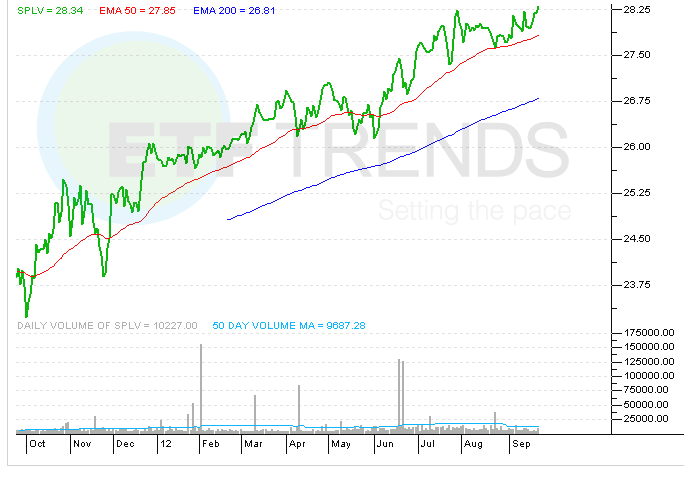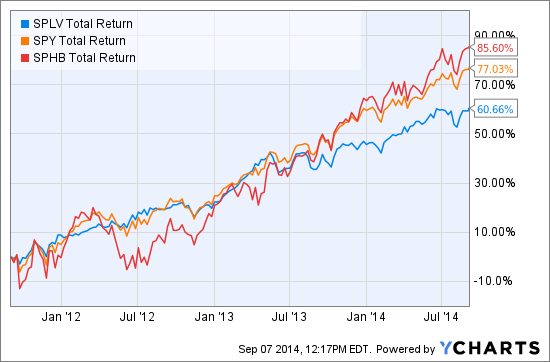The Coming Rise Of Volatility In Low Volatility ETFs
Post on: 29 Май, 2015 No Comment

Summary
- Low Volatility ETFs have outperformed the broader S&P 500 by 17% since 1991.
- SPLV beat the S&P 500 while exposing investors to 25% less risk as measured by standard deviation.
- Low Volatility ETFs violate the Capital Asset Pricing Model taught in every business school in America.
- What has made these investments so successful will not work going forward.
With volatility in the stock market increasing in the last month, many investors are looking at low volatility ETFs as a way to protect their portfolios; and for good reason. Since beginning in 2011, the number of low-volatility ETFs has increased from two to fourteen, and AUM now exceed $9.7 billion.
Low-volatility ETFs track everything from emerging markets to global stocks, and have proven to be among the most popular investment vehicles in 2014. But do low-volatility ETFs actually perform as promised?
The PowerShares S&P 500 Low Volatility ETF (NYSEARCA:SPLV ) began trading in 2011, and has backdated data available from 1991. Using that backdated data, I have constructed a chart below showing the performance of the S&P 500 index compared to the low-volatility ETF from 1991 — 2013.
While it may not be immediately clear from the chart, an interesting fact becomes evident when analyzing the data. Against all expectations, SPLV outperformed the S&P 500 index with a compound annual growth rate of 9.93% compared to 8.22% for the S&P 500 Index — a difference of more than 1.7%!
What isn’t surprising is that the SPLV accomplished this with a lower standard deviation. The standard deviation for the S&P 500 low-volatility ETF was 14.27% versus 19.09% for the broader index — a difference of more than 25%.

Now, what makes this data interesting to economists is that these results fly in the face of the Capital Asset Pricing Model (CAPM) taught in every business school in America. You see, CAPM predicts a positive relation between risk and return — with higher expected returns associated with higher risks.
This means low volatility portfolios should underperform the broader markets over time since they are exposed to less risk.
But that didn’t happen. And this was no anomaly, either; the PowerShares S&P International Low Volatility ETF (NYSEARCA:IDLV ) and the Russell 1000 Low Volatility ETF (NYSEARCA:LGLV ) show similar results:
- IDLV posts a 20-year CAGR of 10.09% versus a return of 5.57% for the broader index of developed market stocks, while posing 23% less risk.
- LGLV returned 7.88% over a ten-year period with a standard deviation of 13.10% against a return of 7.49% for the broader Russell index with a standard deviation of 18.9%.
These results have created a Volatility Effect. which can best be explained by low stock valuations in low volatility ETFs. In other words, low-volatility investing is another form of value investing — which just happens to be a smart way to invest.
But it’s important to remember that low volatility ETFs are not perfect investments. The second largest low-vol ETF, the iShares MSCI USA Minimum Volatility ETF (NYSEARCA:USMV ) is broadly diversified, but is still heavily weighted in health care (18.63%) and consumer staples (15.95%).
Consumer stocks are trading 32% ahead of their long-term trend, which means they will struggle to go higher from these lofty levels — and the same could be said for health care stocks. This means USMV is susceptible to sharp declines in a correction; SPLV is also susceptible to a correction.
Its largest weighting is utilities, which make up 23.8% of the ETF — leaving it vulnerable to sharp declines when interest rates finally begin rising. And a foreshadowing of these vulnerabilities was evident last month.
The chart below illustrates the July performance of several ETFs, and shows the rather precipitous drop experienced by SPLV — which declined nearly four times more than the overall market.
In many ways, the July performance was a warning sign to low-vol investors that low-volatility ETFs have no real track-record in serious market downturns — where it matters most.
For now, a better way to deal with volatility is to buy reasonably priced income stocks with solid histories of raising dividends. After all, that’s how low-vol ETFs became a popular investment option in the first place.
Disclosure: The author has no positions in any stocks mentioned, and no plans to initiate any positions within the next 72 hours. (More. ) The author wrote this article themselves, and it expresses their own opinions. The author is not receiving compensation for it. The author has no business relationship with any company whose stock is mentioned in this article.














